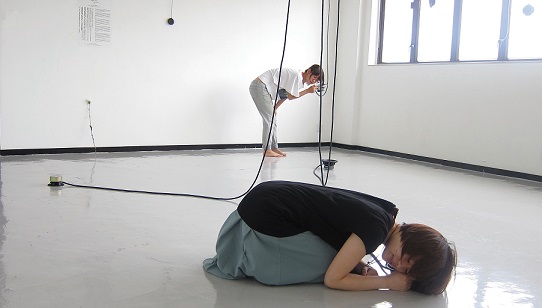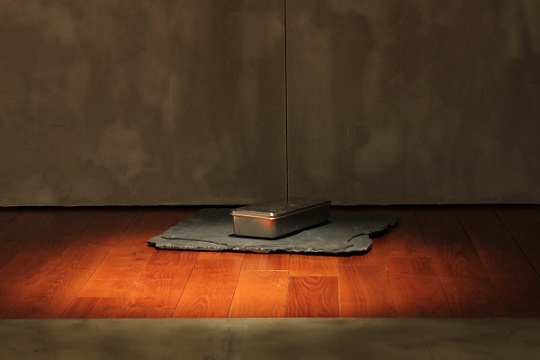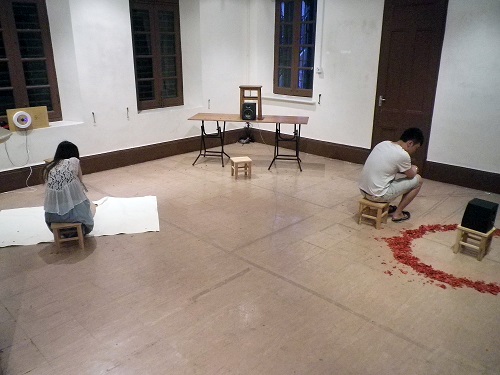藝評
Yip Kai-chun
楊陽 (Yang YEUNG)
at 2:23pm on 24th November 2015



Captions:
1. - 2. Installation views of the exhibition ‘Incomplete Finale’. Photos: Courtesy of the artist.
3. - 4. Installation views of the exhibition ‘away’. Photos: Courtesy of Mur Nomade Gallery.
5. Installation view of the exhibition ‘voice from the root, reclaiming’. Photo: Courtesy of the artist.
(原文以英文發表,評論葉啟俊的展覽作品。)
“This is a case in which I need more than words to find the meaning.
This is a case in which I need whatever it is I think or believe
to be penetrable, if only for myself.”
(Joan Didion, The Year of Magical Thinking)
Where does the death of our loved ones take us? Where does death take us? Incomplete Finale (2015) in the exhibition away is the second artistic iteration by Yip Kai-chun regarding the death of his mother, following the first under the same title three years ago. According to Yip, this would probably be the last one.
The recent Incomplete Finale is a closed tin box, sitting on a roughly edged metallic panel on the ground. His mother’s voice, in conversation with him, is sounded out from within. To listen, one needs to kneel and lean, so our ears touch the cold cover of the tin box. Even then, the voices could come out muffled. Tin domesticated as a box evokes sentiments of intimacy, for promising an unrefined, homely, and miniaturized safety. Yip chooses the tin box because it was an object held dear by his mother.
away – of which Yip is both artist and curator – shows three other works. The centre piece is Foon Sham’s Vessel of Hope. A wooden vessel arises from the ground waist-high, figured to be on the move. Dozens of paper boats made by visitors tail behind it. While no religious references are made on site, Vessel of Hope alludes to the idea from Mahayana Buddhism that the ‘greater vehicle’ cares for all sentient beings. Behind the vessels is Jolene Mok’s You Know Where to Find Me. The video work ponders the geographical, emotional, and symbolic distance between the artist and her grandfather who passed away in Hong Kong when she was in an art residency in Norway. A female voice narrates, navigating the hollow of a divide that is not only immeasurable by coordinates, but also incommensurable in meaning. The urge to make sense of an unfinished trajectory of bondage remains. To Myself 100 Years After by Amanda Cheng (with Soul House (Paper Art) Design Studio) unveils the wish of the artist to live in a house with ample sunlight and a spacious interior in her afterlife. To have the dream realized, the paper house will have to be burnt as an offering to her upon her death. In the light of these three works, Incomplete Finale is a poignant gesture of concealment – present, self-sufficient, nearly defiant.
Yip made this recording of conversations with his mother and many more of them three years ago when she was diagnosed with cancer. With six hours of recordings, Yip made a sonic installation with twelve round speakers, hanging from the ceiling at various lengths facing up, down, sideways, or leaning onto the windows of the room. The sparse distribution of speakers conjures a visual field that is undulating and unhurried. Sonically, one hears, in general, a mix of drone, discernable as human voices, but not as much as human speech. Coming close to any particular speaker reveals an ordinary family conversation mostly over a shared meal – uneventful, unassuming, neutral. The artist seems to have chosen neutrality to be his totality – what began as ordinary lived moments and their subsequent transformation into moments telling of the imminence of death, were turned into a collection of sounds laid bare in space. Instead of presenting the complexity of emotions and dealing with the complexity of sound as a material working in space, Yip exteriorizes the voices in one stroke.
Not long ago, Yip presented a solo exhibition at The Conservancy Association Centre for Heritage entitled voice from the root, reclaiming. The way he handled the collection of conversations primarily between him and his father on speaking and learning his native language of Hakka was starkly different. In this exhibition, a particular conversation about a scenario of his father’s past took up one small part of the gallery. Specific listening positions were set up – one might sit on a stool and listen to a radio; one might stand and lean against a window and listen with headphones; one might also sit among a group of three or four, listening together. There was an ecology of sonic materials as much as physical objects – domestic, digital, found and made, coming into dialogue with each other. In all of these listening situations, Yip and his father’s voices came across as a story and a journey open for listeners to join.
In comparison, the listening situation in the early version of Incomplete Finale primarily communicates blandness rather than a clear organizing principle based on structure or scheme. Blandness may convey a state of boredom in some cultures, as if no taste or variety is at hand. I take blandness in a positive way, inspired by Jullien Francois’ account of blandness in the landscape of ink paintings in In Praise of Blandness, Proceeding from Chinese Thought and Aesthetics. “Near and far are fundamentally homogeneous, ‘reflecting each other’,” he says. The blandness of things, he furthers, “evokes in us an inner detachment. But this quality is also a virtue, especially in our relations with others, because it guarantees authenticity.” Blandness may not offer theoretical rigor, but “as different flavors no longer stand in opposition to each other but, rather, abide within plenitude”, we remain in the realm of perceived experience. What prompted this blandness in Yip’s installation? Was it by choice, by exigency, or circumstances that he might or might not be able to specify? It is not clear, but the blandness is at least a careful exteriorization of her mother’s body as voice, the body that is to leave this world with his voice in hers.
If Incomplete Finale is to be regarded as Yip’s personal collection of sound, he had resisted the temptation of turning the collection into an autobiography. Instead of materializing the recordings as his story, he renounced the inwardness of his listening (to borrow Roland Barthes’ idea in The Responsibility of Forms), and invited us to listen as he did without understanding or judgment. But impersonation has its price, too. When Yip listened to the recordings again for the new iteration, he encountered a reason to stop. “I knew exactly what would be said at what point, and it was too mechanical,” he said. The impersonation became unbearable, for being dehumanizing. Incomplete Finale as the tin box becomes a way of returning humanity to the bondage between him and his mother.
Incomplete Finale has therefore gone through two levels of transformation – first, as a collection of materials, and second, as sound. In On Longing, Susan Stewart says to understand the principles of organization in a collection, “[it] is not sufficient to say that the collection is organized according to time, space, or internal qualities of the objects themselves, for each of these parameters is divided in a dialectic of inside and outside, public and private, meaning and exchange value. To arrange the objects according to time is to juxtapose personal time with social time, autobiography with history, and thus to create a fiction of the individual life, a time of the individual subject both transcendent to and parallel to historical time.” Yip’s collection began as personal time, corporealizaed as social time shared by listeners invited into the distribution of the collection in space. The collection then becomes one object that cancels out the space between bodies in shared listening. The collection recedes, and the illusion of totality and wholeness subsides, as does the desire to decipher. The tin box itself becomes the collection. As sound, the bland soundscape is compressed into silence – what we are listening to, along with Yip.
Is the work of mourning complete? I am not sure, but I think there is a certain deafening anxiety that while the first Incomplete Finale was wrestling with by sounding out, the second Incomplete Finale has overcome. Salome Voegelin, in Listening to Noise and Silence, speaks of silence as “not the absence of sound but the beginning of listening. This is listening as a generative process not of noises external to me, but from inside, from the body, where my subjectivity is at the centre of the sound production, audible to myself.” In Incomplete Finale, the process from not hearing to excessively purposeful listening, and eventually listening to and with silence is Yip’s personal work of mourning – work as labour, work as what art does, and work as art work. The silence of his mother’s absence is closer and safer to be listened to for the artist. It no longer takes over his life. He is listening again.
At one point, Yip said he was motivated to work on the exhibition because the topic of the death of loved ones may have been too personal to be encouraged in contemporary art. Too personal, perhaps, but not encouraged? I am not sure. It is not rare to encounter works by young artists in art school graduation shows addressing issues of sickness and death of family members, and in the galleries, the recent My Father is Over the Ocean (2013) by Au Hoi-lam may be another example. The transformation of the personal requires hard work; when personal does receive the work, even the most personal communicates by defying possession and compelling empathy and reciprocity.
Where does death take us? For Yip, death seems to have taken him into art, and art, onto an unprecedented journey of inquiry, shown him its limits, and since, gently nudging him on.
First published in issue 117 (Nov 2015) of a.m.post:, Hong Kong.
原文刊於《a.m.post:》117期,2015年11月。
